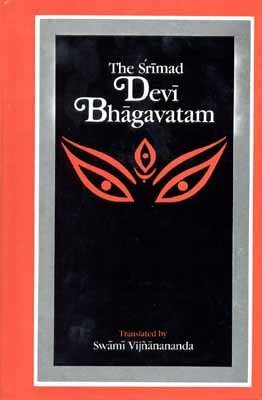The Devi Bhagavata Purana
by Swami Vijñanananda | 1921 | 545,801 words | ISBN-10: 8121505917 | ISBN-13: 9788121505918
The English translation of the Devi Bhagavata Purana. This Sanskrit work describes the Devi (Divine), the Goddess, as the foundation of the world and as identical with Brahman, the Supreme Being. The Devi Bhagavata Purana is one of the most important works in Shaktism, a branch of Hinduism focusing on the veneration of the divine feminine, along w...
Chapter 16 - On the Birth of the several Avatāras of Viṣṇu and their deeds
1-2. Janamejaya spoke :-- O best of Munis! How did Viṣṇu, of wonderful deeds, get his incarnation owing to the curse, cast on Him by Bhṛgu? what were His different incarnations in different Manvantaras respectively? O Thou, well versed in religion! O Brāhmaṇa! Kindly narrate those sin-destroying deeds of Hari in His several incarnations, that are the source of happiness, peace and welfare to all humanity.
3. Vyāsa said :-- O king! Hear, I am narrating to you the incarnations of Śrī Bhagavān Hari which He had in the several Manvantaras and in the several Yugas respectively.
4. I will tell you now, in brief, what forms He took and what deeds He did in the various incarnations.
5. In the Cākṣusa Manvantara, the Bhagavān Hari took the incarnation of Dharma; and the two sons of Dharma, Nara Nārāyaṇa, were widely celebrated in this world.
6. Then, in the present Vaīvasvata Manvantara, under the reign of Vaīvasvata Manu in the second Yuga, Bhagavān Hari incarnated as Dattātreya, in the shape of the son of Atrī Ṛṣi.
7. Anasūyā the wife of Atrī, was desirous to have, as her sons, the three Devas Brahmā, Viṣṇu and Rudra; and in fulfilment of her desires, the Devas took their births in her womb.
8. Anasūyā, was foremost amongst the chaste and virtuous women and on her praying, Brahmā, Viṣṇu and Rudra the Trinity at once agreed to become her sons.
9. Brahmā was born as Soma, Hari was born as Dattātreya and Rudra was born as Durvāsā.
10. In the fourth Yuga, the Bhagavān assumed the beautiful double form in one, the upper part resembling a lion and the lower part a human being to accomplish the noble purpose of the Devas.
11. It was to kill Hiraṇyakaśipu that the Bhagavān Hari assumed this appearance, wonderful even to the Devas.
12. In the Tretā Yuga, the superior and the best of all the Yugas, the Bhagavān incarnated as Vāmana ( the Dwarf), the son of Maharṣi Kaśyapa, to curb the power of Bali.
13. The Dwarf Hari took away by pretext, the kingdom of Bali, while he was performing a sacrifice and sent him down into the Pātāla (the lower regions).
14. Afterwards, in the nineteenth Yuga, known as the Tretā Yuga, Śrī Bhagavān Hari incarnated as Paraśurāma, very powerful and the son of Jamadagnī Ṛṣi.
15. He was very beautiful and graceful in his body, truthful and the conqueror of his senses. He extirpated the Kṣattriya race and gave the whole world over to the high minded Ṛṣi Kaśyapa.
16. O king! He is the Paraśurāma, the sin-destroyer, the incarnation of Hari, and the doer of wonderful deeds.
17-20. After that the Bhagavān Hari incarnated as Rāma, the son of Daśaratha. Next in the twenty-eighth Dvāpara Yuga, He incarnated as the very powerful Arjuṇa and Śrī Kṛṣṇa, the Aṃśas of Nara Nārāyaṇa. To remove the load of the earth, these two were born; and they fought deadly battles in the battlefield of Kurukṣettra. O king! Thus the several incarnations of Hari arose, according to the requirements of Prakriti. O King! These three worlds are under the control of Prakriti.
21. Whatever the Prakriti wishes at any time, She can fashion the world in that way. And She does this incessantly in accordance with the Word Divine, the Highest Śakti, to please the Puruṣa, without any cessation.
22-23. In days of yore, the most ancient Bhagavān, the Highest, above all the qualities of Māyā, formless, all pervading, difficult to be conceived, without any decay, self-supporting, without any want, created these worlds, moving and unmoving and He manifested Himself as the Trinity, Brahmā, Viṣṇu, Maheśa in the shape of the three qualities Sāttva, Rājas and Tāmas, and which is called the Highest Prakriti.
24. This all auspicious Prakriti shines differently according to the differences in time and circumstances. This threefold Prakriti, the Great Enchantress of the world is creating, preserving the worlds and is destroying them at the end of the Kalpas.
25. O King! Whenever there takes place the union with this Prakriti, Brahmā creates, Viṣṇu preserves, and the all-auspicious God Śaṅkara destroys the worlds.
26. It was She That gave birth to Kākutstha, the best of the kings; and to conquer the Dānavas, She placed him at a certain place.
27. O king! Thus all men controlled by the Great Law in this world, enjoy sometimes the pleasures, enjoy sometimes pains and thus exist in the world.
Here ends the Sixteenth Chapter in the Fourth Book of Śrī Mad Devī Bhāgavatam, the Mahāpurāṇam of 18,000 verses, by Maharṣi Veda Vyāsa, on the Birth of the several Avatāras of Viṣṇu and their deeds.
